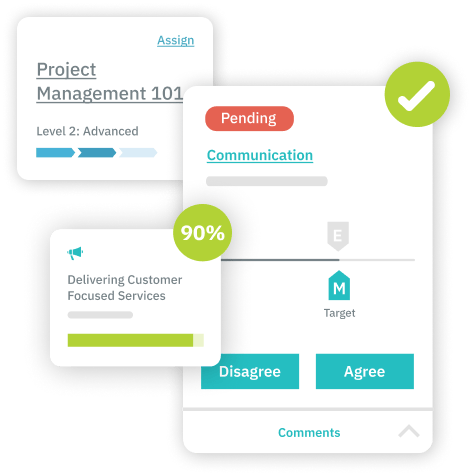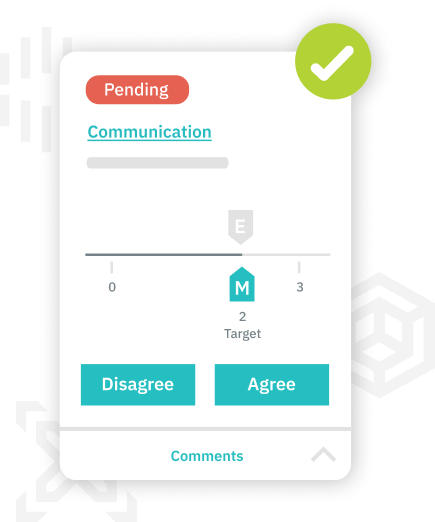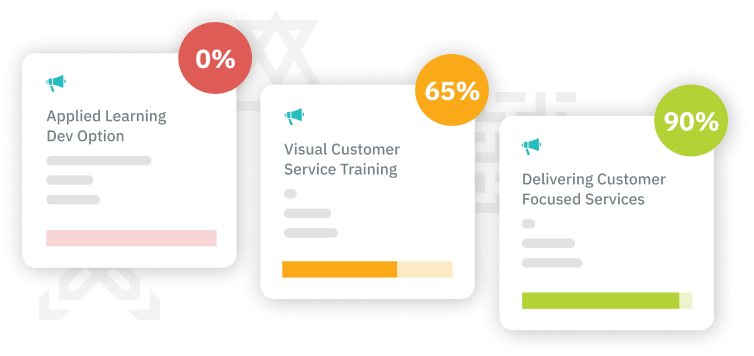
Employee Assessment Tool
Know exactly what your people can do
Our platform provides the employee assessment tool you need to deploy tailored job-based assessments that measure the skills most relevant to an employee’s role, according to your career architecture. Learn exactly what your employees can do so you (and they) can apply their talents now and plan their future development.

Employee Assessment Tool
Employee assessment tools offer a clearer understanding of each employee’s capabilities and provide valuable insights for career development. These tools not only benefit the organization but also empower employees by highlighting the skills they need to advance in their careers. Through structured feedback, employees can better understand where they excel and where improvement is needed.
The employee assessment process can be complex. You may have encountered an employee who excels independently but struggles with leadership, or someone who leads a team well but has difficulty with specific project tasks. Each employee has unique strengths and weaknesses, and navigating these can be challenging.
These tools are easy to use yet provide deep insights. The process typically begins with a self-assessment, where employees rate their own skills and performance. Then, their direct manager reviews and verifies these ratings, ensuring an objective evaluation. Interestingly, employees often have a skewed perception of their abilities—not always overestimating, but sometimes underestimating their own strengths. By combining the employee’s self-assessment with the manager’s review, you gain a more accurate and well-rounded understanding of their competencies.
Using assessments that incorporate both employee and supervisor ratings offers a clearer, more comprehensive picture of each individual. This method helps identify key strengths, areas for development, and provides a roadmap for future growth. By aligning employee self-perception with management insights, organizations can more effectively support employee development and performance improvement.
Employee assessment tools are essential for understanding and developing talent within your organization. They foster a deeper awareness of employee capabilities, encourage skill development, and ensure that both employees and managers have a clear path for career growth and role mastery.
To learn more about TalentGuard’s Workforce Intelligence Platform, please request a demo. We look forward to helping you create an assessment process to measure employee skills and competencies. Let’s get started today.

Gap analysis
Assess the gaps between your employee’s current skills and the targeted skill benchmarks to accomplish organizational goals.

Unbiased skill verification
Assess, rank, and verify skills to understand gaps between self-perception and manager ratings. Identify ingredients for alignment, feedback, goal setting, and development.

Curated Learning Plans
Understand your employees’ strengths and gaps so you can direct their professional development based on where they are, where they’d like to be, and what your company needs.

Documented new skill development
When employees learn new skills, they can document their achievements, request feedback from their manager, and track their progress toward development goals.
Get Your Free Demo & See our Platform in Action
Select from one of the bundles below and we will tailored the demo to your needs. Let us show you how TalentGuard’s solutions adapt to your industry.
Automate
Create skill profiles, create detailed job descriptions, align learning content with specific skills, and chart clear career path progressions to set the foundation for effective talent management.
Automate includes:
- Create Skill and Competency Profiles
- Develop Job Descriptions
- Map Learning to Skills and Competencies
- Map Career Path Progressions
Assess
Effectively assess their employees’ skills, identify gaps, and implement strategies to develop a skilled and competent workforce prepared to meet current and future challenges.
All the Automate features plus the ability to:
- Create a Skills Inventory
- Conduct Gap Analysis
Engage
Organizations can significantly enhance their talent development strategy and workforce effectiveness by assessing employee skills, curating personalized learning paths, recommending appropriate career paths, and tracking career goals.
All the Automate features plus the ability to:
- Assess Employee Skills and Competencies
- Curate Personalized Employee Learning Paths
- Recommend Employee Career Paths
- Track Career Goals
Optimize
Building talent pools, measuring employee performance, tracking certifications, and conducting multi-rater feedback enhance talent management, ensure compliance, and foster organizational leadership development.
All the Engage features plus the ability to:
- Build Talent Pools
- Measure Employee Performance
- Track Employee Certifications
- Conduct Multi-Rater Leadership Feedback
Trusted by:




Your workforce is changing. Never be unprepared again.
Read our eBook
HR Assessment Tools
Talent assessment tools for succession planning help your HR department develop fully functional internal recruitment assessment methods. Succession planning is an important aspect of employee retention because many of your employees are looking for organizations that will promote from within.
An organization that devotes resources to helping staff grow professionally sees higher rates of job satisfaction and a much lower rate of churn in employees. When employees are happy and stay longer, organizations build a better culture and a more productive workforce.
The HR assessment template allows your managers and HR professionals a seamless process to build out succession planning based on the employee skills assessment questionnaire and other HR assessment methods. The tools available on a platform solution give your managers and HR professionals the ability to generate reporting features that showcase individual departments and whole organizational needs. You can effectively pinpoint which skills you have gaps in so that you can develop training opportunities to increase competency among staff.
HR can use these tools to help individual employees plan their career trajectory. They can also use these tools to make certain that your teams have the perfect skill sets available for any project as it happens. Management will be able to see when cross training is a possible solution to staff shortages and they can highlight members that might be developed for promotion in the future.
Skills Assessment Tools
Skill assessment platforms offer your team an all-in-one solution to help assess skills and keep talent management data in one place. This makes the task of assessing individual employees and working with succession planning far less complicated for management and HR staff.
One database houses all of the information and you can easily access employee records as you need them. You can also cross check employees by skill. For instance, if you need an employee on a team to have a specific proficiency, you can search by that skill and competency level to find a list of current employees who match the search criteria.
The skill assessment methods used on your platform are uniform, so that you can adequately compare different skills assessment surveys from employee to employee. This makes it much easier to see how one employee’s skill level stacks up against another’s.
With a database solution, you can generate skills reporting for the entire team or organization. This can help your HR department determine which skills your organization needs to build and offer options to further training. It can also help with succession planning in the organization. For your employees, the skills assessment tools give them an opportunity to see where they might benefit from more training and what types of skills they need to improve in order to prepare for the next position they want to obtain in their careers.
Best Employee Assessment Tools
There are a variety of tools to assess skills and competencies. There are free competency assessment tools you can try, and a selection of assessment examples you can find. However, it takes a lot of manual work for HR and management to go through testing results and assessment records without a comprehensive way to compile them.
An assessment platform offers the best option because the assessments are designed with human resource expertise. All of the tools and assessments are available in one location, making it much easier to use for management and employees. This all-in-one solution can scale with your business. Whether you have fifty employees, or fifteen hundred, you can easily see which skill sets you have available in your current workforce. This makes it much easier to highlight employees for promotion and cross-training opportunities.
An added benefit to the options available in a platform solution is the ability to predict needs in your workforce. You can proactively look for skills that may be lacking currently so that you can build training opportunities to address these skill gaps and offer better advancement opportunities to current staff.
For employees, a platform solution is also a great benefit. Employees can take advantage of the opportunity to take skills assessments that can help them move toward career goals. They can easily see which skills are missing, which means that they take steps to add the learning and experience they need to their resume in order to move forward. Employee skill assessments can also offer a good way for employees to build confidence in their abilities to perform current and future job requirements, while showing them exactly how to build new skills to succeed.
Platform solutions give your business an efficient way to gather skill information about the entire company. The platform allows you to generate reports to help manage human resources, develop initiatives for company growth, and foster a supportive system for all employees to flourish.
